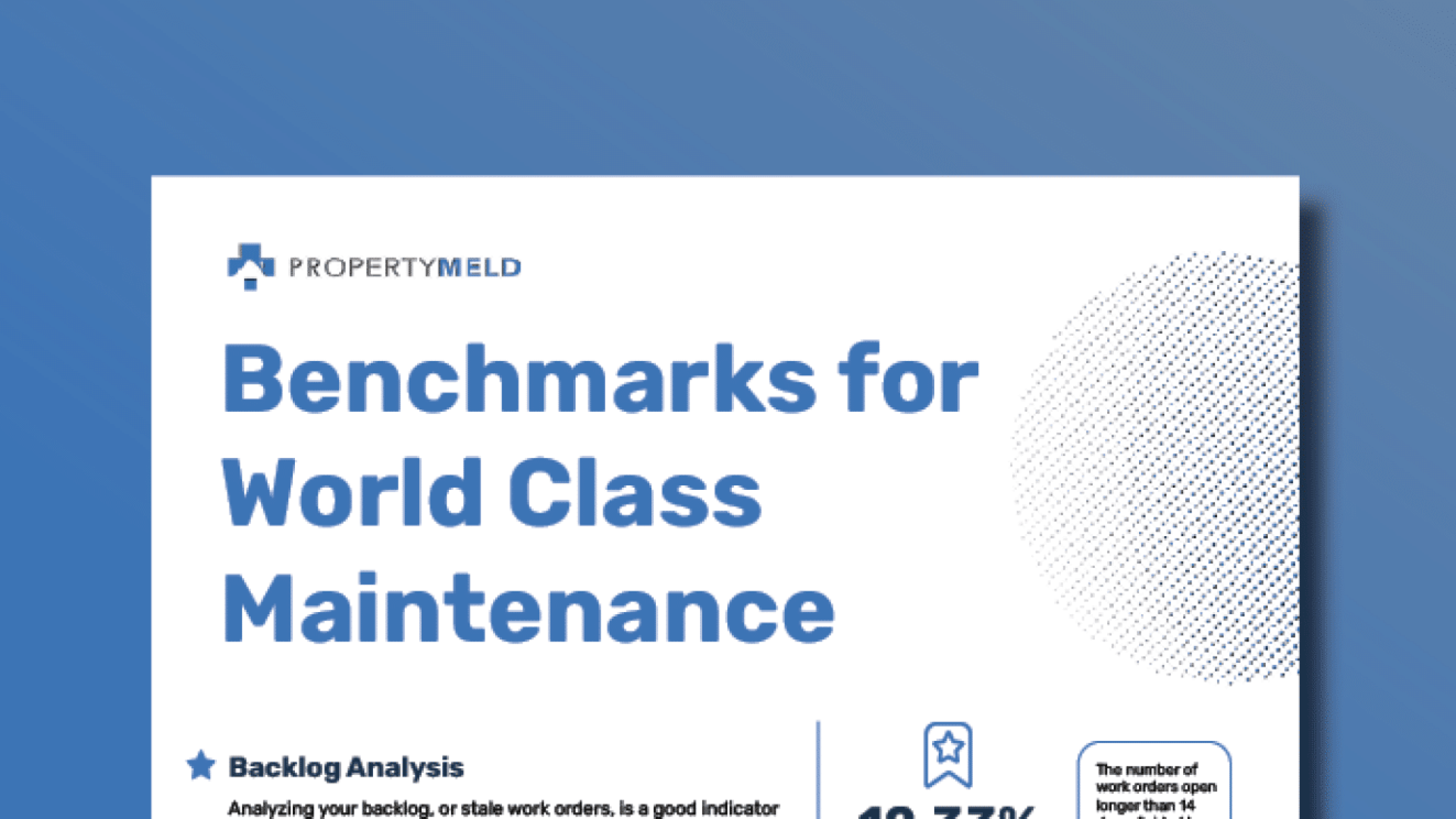Property maintenance benchmarks refer to the standards or criteria used to assess and measure the performance and efficiency of property maintenance operations. These benchmarks serve as reference points or goals that property owners, property managers, and maintenance teams aim to achieve to ensure that properties are well-maintained and operating effectively. They are essential for establishing a baseline for performance, identifying areas for improvement, and ensuring that maintenance practices meet industry standards.
Regularly tracking and evaluating industry maintenance benchmarks can help property management companies make data-driven decisions to improve property management, reduce costs, enhance resident satisfaction, and see how they compare against their competitors.
According to IBISWorld, there are over 296,000 property management businesses in the United States. This means the competition is fierce and if property management companies are falling short with the industry, they will lose owners and residents to their competitors. Analyzing property maintenance benchmark data regularly is a great way to ensure your company is on track with others in your region.
Historically, the challenge in monitoring maintenance benchmarks has been the unavailability of relevant data.. With Property Meld Insights Pro, you can leverage an immense amount of maintenance data collection to provide world class, average, and mediocre, benchmarks for a variety of maintenance metrics. Property managers can view benchmark data by region to compare their metrics to their direct competitors.
What are Important Property Maintenance Benchmarks?
Property management companies have many different metrics they can track to determine the success of their maintenance process. Depending on your goals there may be specific metrics you want to pay closer attention to. The below list includes some of the most important metrics property management companies should be paying attention to.
Speed of Repair:
Measures how long a repair takes to complete from resident submission to invoicing. Property Meld data shows a world class speed of repair is 2.7 days.
Speed to Schedule:
Speed to schedule is the measure of how long it takes for a repair to be scheduled after it has been assigned to a vendor or technician. This is a measure of how effectively your team communicates and if you have any issues with scheduling efficiency. You should be scheduling work orders within hours, not days.
Speed to Assign:
This measures how long it takes for a work order to be assigned to a vendor or technician after it is submitted. Customers using Property Meld have a speed to assign of 0 because our customers have set up automation to instantly assign work to the proper vendor or tech.
Technician Response Time:
Measures the speed at which technicians reply to messages from residents, maintenance coordinators, or the property manager. Tracking this metric helps identify if you have any communication issues.
Vendor Response Time:
Measure the speed at which your vendors reply to messages. This is a great way to track how your vendors are communicating and helps you identify your best vendors, or ones that may not be meeting your standards.
Average Vendor Invoice Costs:
The typical or standard amount a vendor charges for their services or supplies related to property upkeep and maintenance. This information can be useful for budgeting purposes, comparing quotes from different vendors, and identifying any significant deviations from the standard rates. Keep in mind this may vary based on the time of year, location, and the type of work being done.
Average Resident Satisfaction:
Average resident satisfaction measures how satisfied residents are with the maintenance work being done. This metric is extremely important because unhappy residents are more likely to move out. If your competitors have higher rates of resident satisfaction you may be losing residents to them.
Technician Utilization Rate:
Technician utilization rate is a comparison of how much work hours a technician logs, compared to their total hours. For example, if a technician works a 40 hour week and logs 32 hours of work, their utilization rate is 80%. This metric helps you measure the productivity of your internal technicians.
Owner Approval Response Time:
Many property management companies request owner approval for maintenance costs over a certain threshold. However, waiting on owner approval can slow down the repair process. Tracking this metric helps you determine if you have effective communication with your owners and investors.
Why is Benchmark Data Important?
Property maintenance benchmark data is important for several reasons:
1: Cost Analysis and Budgeting:
Benchmark data allows property owners, managers, and stakeholders to compare their property maintenance costs against industry standards or similar properties. It helps them identify areas where costs may be higher than average and make informed decisions about budget allocation and cost-saving measures.
2: Performance Evaluation:
By comparing maintenance metrics to industry benchmarks, property managers can assess the efficiency and effectiveness of their maintenance operations. They can identify areas that require improvement and set performance targets to enhance the overall maintenance experience.
3: Vendor Evaluation:
Benchmark data enables property owners and managers to evaluate the performance of their vendors. They can determine if the costs charged by vendors align with industry averages and if the level of service provided meets or exceeds expectations.
4: Identifying Opportunities for Efficiency:
Benchmarking allows property managers to identify opportunities for operational efficiency. They can learn from best practices in the industry, adopt innovative maintenance techniques, and streamline processes to reduce costs and improve service quality.
5: Data-Driven Decision Making:
Monitoring benchmark data enables data-driven decision-making in property maintenance. It helps avoid making decisions based on assumptions and ensures that choices are based on real data and industry standards.
6: Trend Identification:
Analyzing benchmark data over time can reveal trends in property maintenance costs, service quality, and industry standards. This information is valuable for long-term strategic planning and forecasting.
7: Performance Incentives:
In some cases, property maintenance benchmark data can be used to create performance incentive programs for maintenance staff or vendors. By setting goals based on industry benchmarks, managers can reward outstanding performance and motivate their maintenance team members to excel.
Overall, property maintenance benchmark data serves as a valuable tool for property managers to optimize maintenance operations, control costs, improve service quality, and enhance overall property management efficiency. It empowers them to make informed decisions that positively impact the property’s value, resident satisfaction, and the return on investment (ROI). It also helps property managers make a case to their property owners to back up their buying decisions with facts.
How Can You Measure Your Efficiency?
Some of the top property management companies can measure their maintenance efficiency by implementing various performance metrics and tracking key indicators. Here are some methods they can use:
1: Response Time:
Measure the time it takes for maintenance requests to be addressed and completed. Shorter response times indicate more efficient maintenance operations.
2: Repair Speed:
Track the time it takes to resolve maintenance issues from the moment they are reported to the point of completion. As we mentioned above, a world class repair speed is considered 2.7 days.
3: Number of Trips per work order:
Monitor the percentage of maintenance issues that are resolved on the first visit by maintenance staff. If your maintenance team is making multiple trips to resolve one maintenance issue, you are losing money and repair speeds will increase.
4: Preventive vs. Reactive Maintenance:
Measure the ratio of preventive maintenance tasks (scheduled maintenance to prevent issues) to reactive maintenance tasks (addressing issues after they occur). A higher percentage of preventive maintenance suggests a proactive and efficient approach.
5: Work Order Backlog:
Track the number of open work orders at any given time. A low backlog indicates efficient workflow management and timely task completion.
6: Resident Satisfaction:
Conduct regular resident surveys to gauge satisfaction with maintenance services. Higher resident satisfaction scores indicate efficient and satisfactory maintenance support.
7: Jobs per Day:
Measure the number of maintenance tasks or work orders completed per maintenance staff member on a daily basis. Higher productivity levels signal greater efficiency.
8: Vendor Performance:
Evaluate the performance of external vendors or contractors who provide maintenance services. Assess factors such as response times, resolution times, and customer feedback to ensure efficient vendor partnerships.
9: Cost per Work Order:
Calculate the average cost of completing a single maintenance work order. Tracking this metric over time helps identify cost trends and inefficiencies.
Efficient maintenance operations not only helps you improve your bottom line, but has a direct impact on your resident and owner churn.
How is Benchmark Data Calculated?
Using the data we have captured over the last 8 years from leading property managers in our platform, we have identified industry trends and created world class, average, and mediocre benchmarks for a variety of key areas. Customers on our platform have the ability to see their maintenance on an incredibly granular level to identify where inefficiencies are occurring. Customers can compare their data to others in their region to see how they stack up against their competitors utilizing Insights Pro.
If you are interested in learning more about how Property Meld can help you track and compare your maintenance data to industry standards, schedule a demo with our team of maintenance advisors.
In the meantime, fill out the form to download our World Class Maintenance Benchmarks, containing key maintenance data points allowing you to see how the rest of the industry is performing.
Download World Class Maintenance Benchmarks






